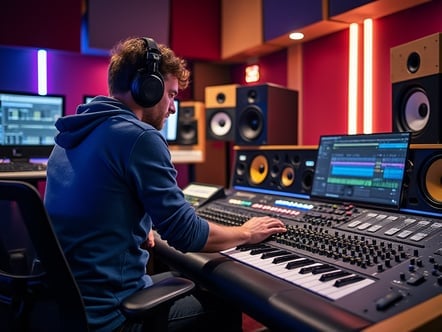New York, NY (Top40 Charts) Achieving the "perfect blend" in music is a delicate process that demands precision, creativity, and technical expertise. For a track to resonate, each instrument and vocal must find its place within the mix, creating a harmonious balance that captivates the listener without overwhelming them. This balance is fundamental to delivering a rich, immersive experience, as each element shines while supporting the overall sound. The journey to this perfect blend involves top mix engineers, mastering engineers, and music producers, whose combined skills craft a polished, cohesive track.
This article explores the techniques, challenges, and collaborative artistry involved in achieving this blend, along with the role of genre-bending innovations that define contemporary music production.
The Roles of Mixing Engineers, Mastering Engineers, and Producers in Balance
Mixing Engineers
Mixing engineers bring each element to life within a track by adjusting volume, equalization (EQ), and effects to ensure clarity and cohesion. Their role involves managing individual sounds—vocals, drums, guitars, synths—so each stands out at the right moment. By controlling levels and panning, mixing engineers allow for spatial clarity and depth. This skill is especially critical in genres where intricate layering is key, such as pop and rock. Through their creative choices, mixing engineers establish the foundation for a track's signature sound.
Mastering Engineers
Mastering engineers refine the final mix, applying subtle but crucial adjustments to optimize the track's playback across devices. They enhance clarity, punch, and dynamic consistency, ensuring the song sounds as intended on headphones, car speakers, and high-end sound systems. A pro mastering engineer adds the finishing polish that gives a track cohesion, while also ensuring it resonates in different listening environments. For Grammy Award-winning projects, mastering is essential to achieving an industry-level shine that captivates listeners worldwide.
Producers as Visionaries
Producers guide the overall artistic vision, shaping the track's "signature sound" and blending musical elements in unique ways. Visionary producers like David Guetta and genre-bending artists like Nine Inch Nails redefine genre conventions, creating sounds that feel fresh and innovative. With genre-bending approaches, producers co-create tracks that appeal to broad audiences, blending elements from hip hop, pop, dance, and even industrial genres. Their work in balancing instruments and vocals allows each song to stand out as memorable and cohesive.
Techniques for Achieving the Right Balance
EQ and Compression
Equalization and compression are vital tools for creating clarity in the mix. EQ allows engineers to carve out space for each element by boosting or cutting specific frequencies, ensuring that instruments and vocals don't clash or muddy the sound. Compression, meanwhile, controls dynamic range, keeping louder sounds in check while bringing softer ones forward. Together, these techniques let mixing engineers create a balanced, polished sound that captures the listener's attention.
Stereo Imaging
Stereo imaging, or panning, positions instruments across the left and right channels, creating a sense of width and space in the mix. For instance, placing background vocals to the left and a lead guitar to the right allows for a fuller sound, giving each part of the track a distinct presence. This technique is especially valuable in pop and rock genres, where instruments like guitars, synths, and vocals are given unique spatial positions to enhance the track's texture.
Volume Automation
Volume automation is a subtle but powerful tool for creating dynamic interest. By adjusting the volume of specific elements at key moments, engineers can emphasize certain parts without losing balance. This might mean boosting the vocal in a chorus or slightly lowering an instrument during a verse to create space for lyrics. Volume automation allows tracks to breathe, maintaining energy and balance throughout the song.
Challenges in Creating a Harmonious Blend
Genre-Specific Challenges
Different genres require unique approaches to balance. Hip hop, for example, often emphasizes bass-heavy beats and clear vocals, whereas pop demands a blend of crisp instrumentation and vocal clarity. Rock and electronic genres, with their layered production, call for careful EQ and spatial placement to avoid sonic overcrowding. Mixing engineers must adapt their techniques to match the style and energy of each genre, creating a mix that resonates with fans of that music style.
Auto-Tune and Vocal Effects
Auto-Tune and vocal effects are integral to modern pop and hip hop, adding a polished, sometimes futuristic sound to vocals. Balancing these effects with instrumental layers requires skill to ensure the vocal remains the focal point without sounding detached. Engineers use effects to complement the instruments while retaining the artist's intended emotion, giving tracks a distinct character that aligns with current music trends.
Managing Competing Frequencies
Instruments that share similar frequency ranges can cause conflicts, leading to muddiness in the mix. For instance, bass and kick drums occupy the low-frequency range, so engineers use EQ to define space for each, ensuring clarity. Techniques like sidechain compression can further separate elements, allowing one sound to "duck" out of the way of another, giving each instrument its own place within the mix.
Spotlight on Genre-Bending Projects and Signature Sounds
Genre-Bending Examples
Grammy Award-winning projects by artists like David Guetta and Nine Inch Nails push genre boundaries, blending electronic, rock, and pop to create unforgettable tracks. These genre-bending projects are often co-produced, showcasing collaboration between artists, producers, and engineers who seek innovative sounds. This blend of influences results in tracks that appeal to diverse audiences, achieving a balance that transcends traditional genre labels.
Signature Sound in the Past Two Decades
Over the last two decades, artists like Taylor Swift and Nicki Minaj have crafted signature sounds with the help of top music producers and mix engineers. Swift's music has evolved from country to pop and folk, each era showcasing a distinct balance that highlights her vocals while experimenting with genre conventions. Nicki Minaj's collaborations with top producers blend hip hop with pop, creating hits that maintain clarity and energy across vocal and instrumental layers.
Creating Global Appeal
Hit records that achieve a balance appealing to global audiences reflect a careful blending of instruments, vocals, and production styles. Songs like David Guetta's "Titanium" and Swift's "Shake It Off" illustrate how top engineers and producers create mixes that resonate universally, ensuring each track feels accessible and impactful across different cultures and listening environments.
Case Studies of Balancing Instruments and Vocals in Popular Tracks
David Guetta's Dance-Pop Hits
Guetta's tracks exemplify the part of balancing vocals with high-energy instrumentation. Songs like "Titanium" and "When Love Takes Over" showcase how powerful vocals can coexist with dynamic beats and synths, creating a cohesive sound perfect for the dance floor. His mix engineers use EQ and compression to highlight both the beat and the melody, making each track infectious and energetic.
Taylor Swift's Evolving Sound
Swift's production has evolved over the years, with top mix engineers crafting her signature sound in multiple genres. From the country-inspired "Love Story" to the pop-heavy "Blank Space" and indie-focused folklore, each era balances vocals and instrumentation to highlight her storytelling. Swift's collaborators achieve a polished, cohesive sound across her discography, ensuring her unique voice shines through.
Nine Inch Nails' Industrial Sound
Nine Inch Nails, known for its genre-bending industrial rock, balances dense instrumentation with haunting vocals. Tracks like "Closer" and "Hurt" feature layered synthesizers, guitars, and effects that create a dark, textured sound. The band's mix engineers use analog and digital techniques to craft a balance that's intense and atmospheric, making their tracks memorable and immersive.
How the Past Decade Has Shaped Mixing and Production Techniques
Advancements in Technology
Digital tools and plugins have transformed the mixing process, giving engineers greater control over each element in the mix. Tools like Auto-Tune, reverb plugins, and EQ enhancements allow for precise adjustments, making it easier to achieve a clean and balanced sound in complex productions.
Rise of Co-Production
The trend of co-produced records has shaped the music landscape, allowing artists and engineers to blend styles and ideas in innovative ways. Collaborative projects bring fresh perspectives, creating multi-dimensional sounds that resonate with broad audiences and highlight the strengths of each contributor.
The Mastering Process as the Final Layer of Balance
Polishing and Enhancing the Mix
Mastering engineers add the final layer of polish, enhancing clarity and cohesion. They ensure that the track's dynamics are consistent and its sound quality is maximized for various platforms, allowing the music to reach audiences in its best form.
In Conclusion
Balancing instruments and vocals is an essential art in music production, creating a cohesive and engaging listening experience. Through the skill and innovation of mix engineers, mastering engineers, and producers, each track achieves a harmonious blend that brings the artist's vision to life. As technology and collaboration continue to shape the industry, the art of balancing will remain at the heart of impactful music production, ensuring that each song resonates with listeners around the world.























